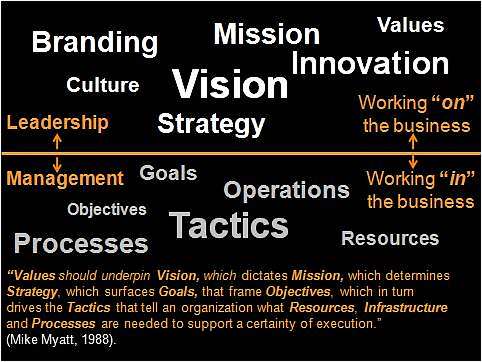
Let me begin by stating that strategy has never been more relevant than it is today. With all of the current emphasis on tactical execution, understand how a question such as the CEO’s could be posed, but it also demonstrates a poor outlook on the state of executive leadership. In today’s post, I will examine the role of strategy in business, as well as the CEO’s responsibilities therein.
Strategy vs. Tactics (Instead Try Strategy and Tactics)
To put it bluntly, the issue should not be strategy vs tactics, but strategy and tactics. While separate functions and disciplines, one cannot prosper without the other. Strategy provides the tactical roadmap; tactical execution validates and delivers strategy. Attempting to lift one up above the other is ineffective. The best strategy cannot succeed without tactical execution, and tactical execution is much easier to achieve with the clarity provided by a sound strategy.
With all of today’s emphasis on pleasing investors by meeting short-term financial expectations, many executives press for better execution when what they really need is a better strategy. Conversely, other executives change strategic direction when what they should do is demand better execution. The truth of the matter is that a sound strategic plan can be executed with a high probability of success, whereas a flawed strategy is almost impossible to execute profitably.
The CEO Has the Ultimate Responsibility for Assuring Strategy Delivery
CEOs need to emphasize creating long-term sustainable value for shareholders without sacrificing short-term tactical interests. While in most cases a sound strategy will also give room to achieve short-term objectives, if you must sacrifice one over the other, you should place long-term interests above short-term objectives. History has shown us on many occasions that it is quite possible to win the battle and lose the war. CEOs must learn to fight the battles that need to be won, and not just the ones that are easy to win.
Please read the following statements very carefully: The CEO is often the chief architect of corporate strategy, and has the ultimate responsibility for assuring the delivery of a strategy that is consistent with the corporate values and vision. The CEO needs to communicate, evangelize, and lead the company in the implementation of the corporate strategy. Unless it experiences blind luck, a company’s strategic planning process is critical to the eventual success or failure of the enterprise. CEOs must view themselves as completely accountable and responsible for the corporate strategy, regardless of whether they were the original architect.
While executives view strategy and execution as inextricably linked, they also must understand that strategy should always drive tactics. Some CEOs tend to let tactics determine the strategy, which is the classic example of reactive vs. proactive leadership. A lack of strategic focus in dictating tactical initiatives is a ready-fire-aim approach to leadership that will result in higher costs, a perpetual state of chaos, and a higher emphasis on activity vs. productivity.
So many businesses focus on execution these days that I often receive a few emails each week with headlines that support “Tactics before Strategy.” While I am all for exploiting trends, and I appreciate a good marketing hook as much as the next person, these emails from so-called business experts can be both misleading and dangerous to those readers who don’t possess the savvy to understand that the emails are simply pitching a product and not giving sound counsel.
As much as some of my direct marketing friends wish it weren’t so, certain inevitable truths do exist in business. I have no problem with creating velocity and leverage, but as fluid as business is today, most of the “short-cuts to success” being marketed today constitute form over substance. You see, business is much like an algebraic formula: while there are certainly formulaic short-cuts that you can take to solve an equation more quickly, you will only have incorrect solutions if the order of operations is skewed.
The Successful CEO Strategy Model
The following visual is one I developed more than forty years ago. Interestingly, the visual is as sound today as it was back in 1988. The orange horizontal line that cuts the image in half is what I refer to as the leadership line. When working above the leadership line, you are working on the business in a true leadership capacity, and when working below the line you are working in the business in more of a management capacity. While all good leaders spend time on both sides of the line, the most effective leaders spend as much time working above the line as possible. Follow this methodology, and the ambiguity surrounding why and where you should spend your time will clear itself up.
For those of you familiar with my work, you know that I have consistently espoused that you need a bias toward action and tactical precision to achieve sustainable success. However, I am also clear in my belief that misguided and ill-timed/advised tactics can create huge problems for any business. The bottom line is that strategy matters, and that as a CEO, strategy is your responsibility. The challenges associated with leading corporate strategy initiatives are not easy, but neither is the burden of leadership.
~~~~~~~~~~~~~~~~~~~~~~
Re-posted with author Mike Myatt’s permission, he runs a great blog at http://www.n2growth.com/blog/ and the original source for this post can be found here:






